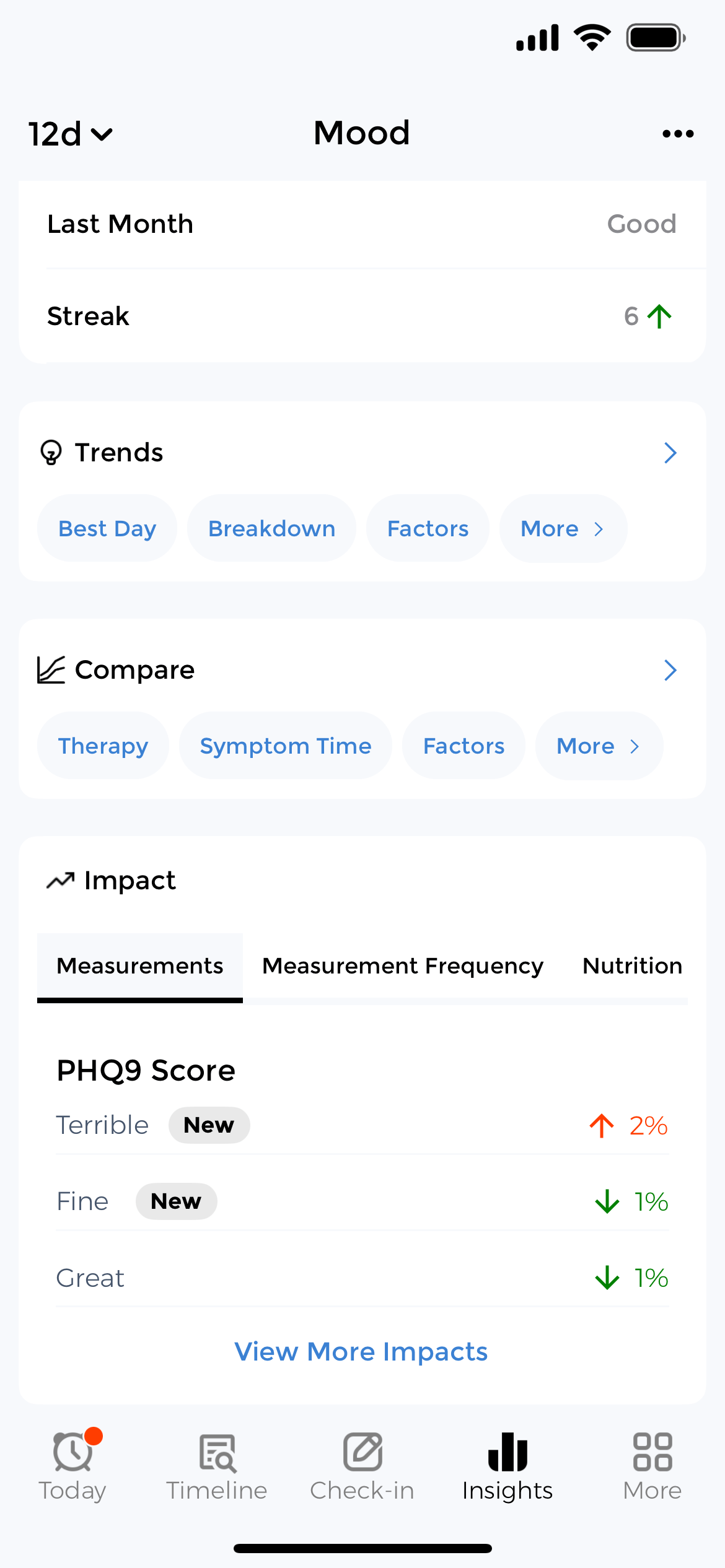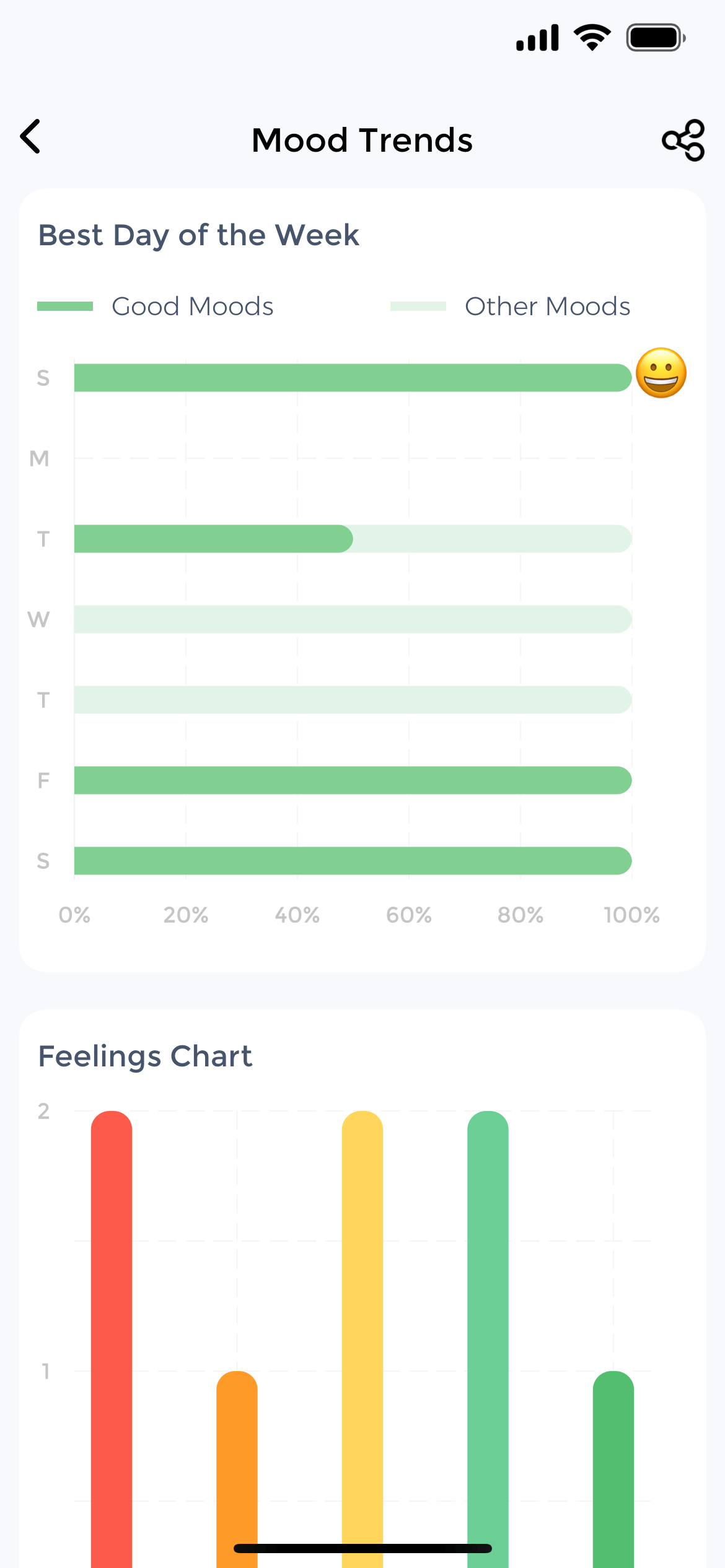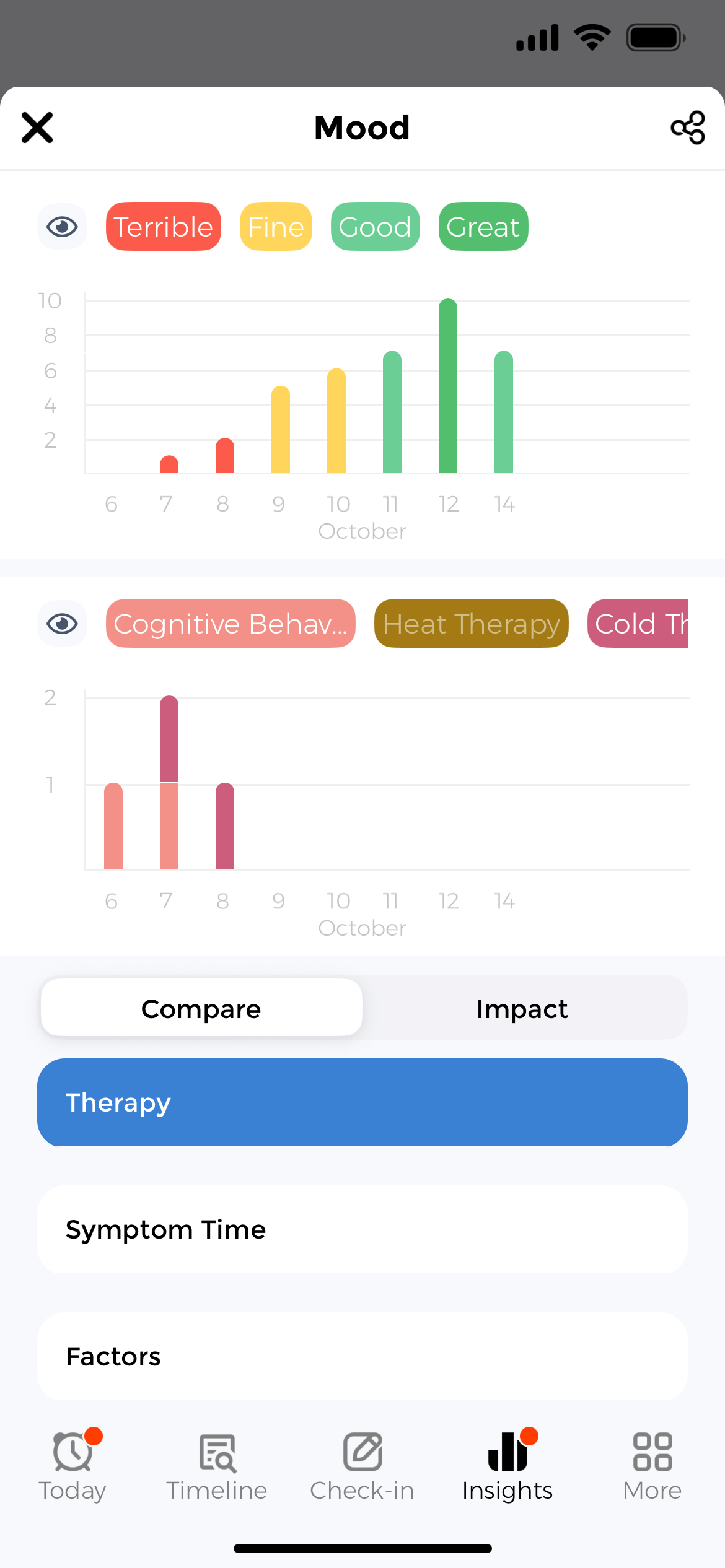Mood Tracker
Track mood changes, emotions, and triggers to understand your mental health patterns.
The best mood tracker app helps you log daily moods, track emotional states, and identify triggers that influence how you feel. Whether tracking anxiety, depression, or general wellness, our free mood tracking app reveals patterns that support better mental health decisions.
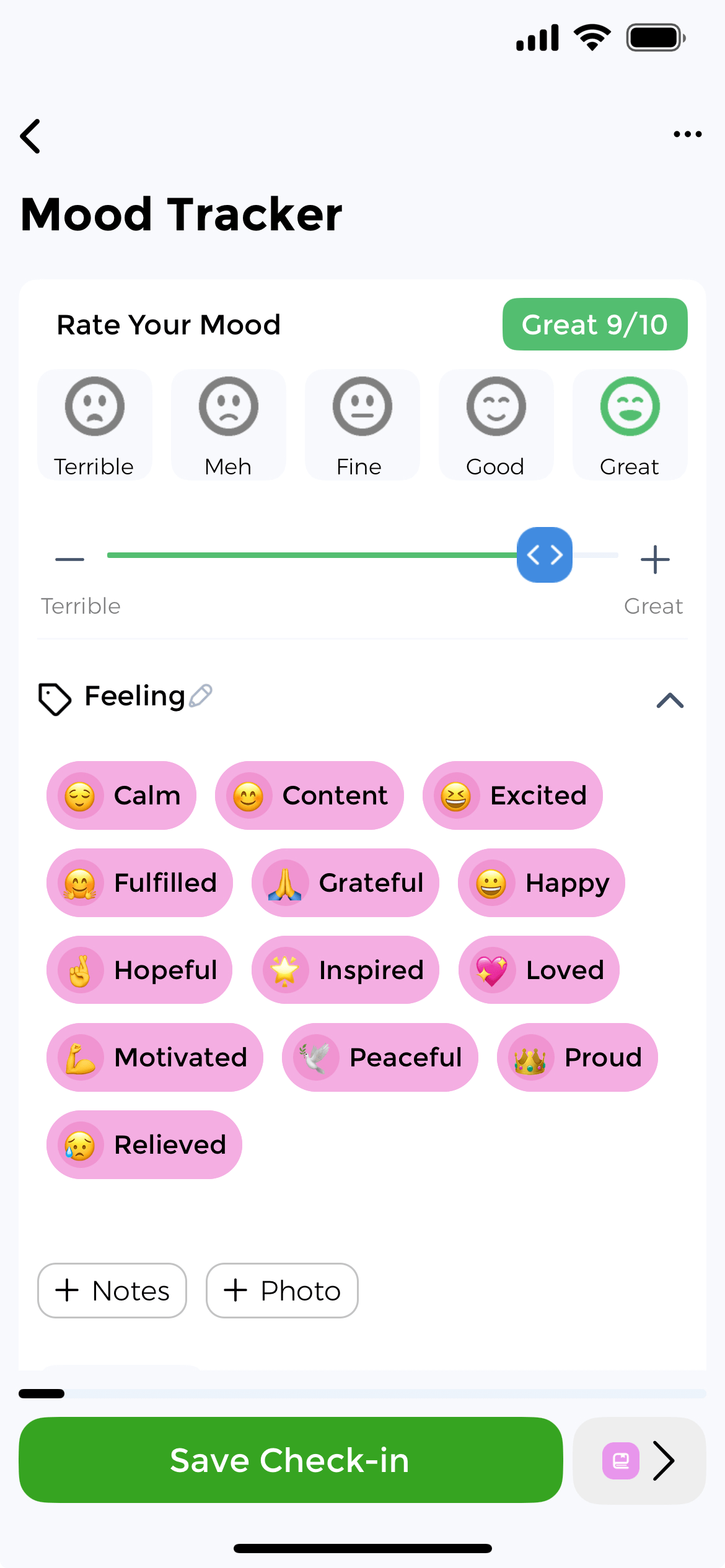
Track with Mood Scale
Understanding your emotional health starts with a simple rating system used by mental health professionals worldwide. This mood monitoring app provides a standardized 1-10 scale with emoji faces for quick, accurate mood logging.
Our emotion tracker app incorporates visual mood ratings from terrible (1) to great (10). You simply tap the emoji that matches how you feel right now. Add emotion tags like anxious, happy, calm, or stressed. This mental health tracker helps you log mood patterns, timing, and triggers that influence your emotional state.
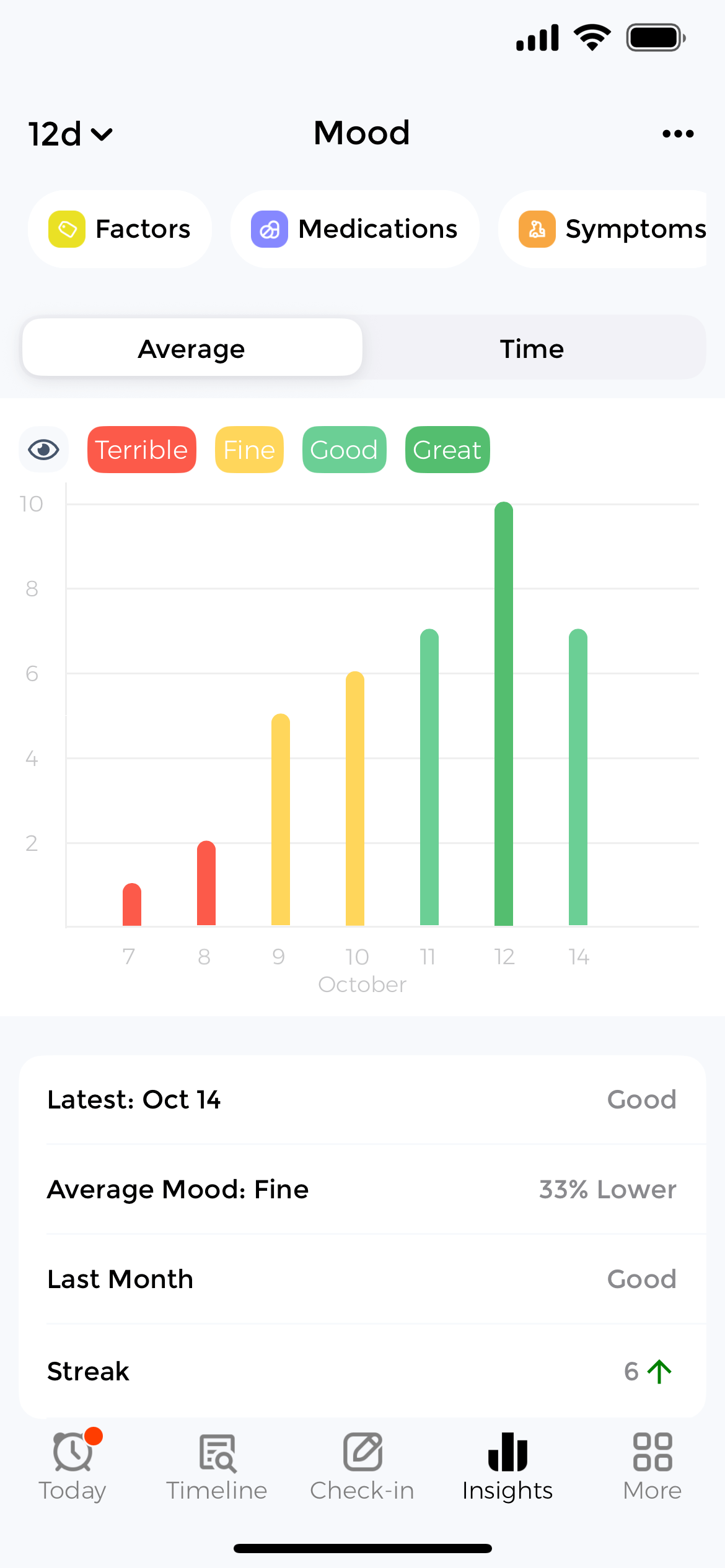
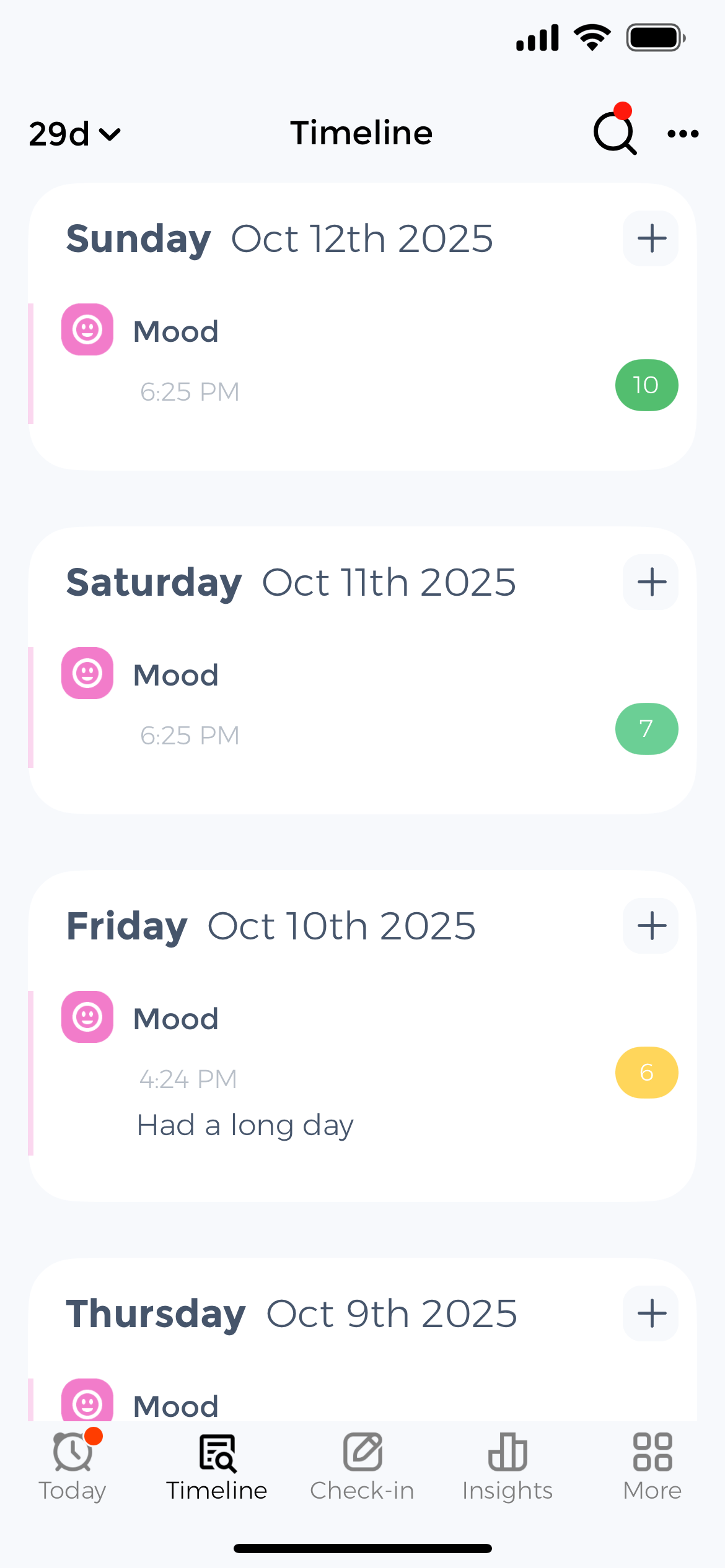
Identify Emotional Triggers
Here is how mental health issues sneak up on you: gradual mood changes become your new normal. Before you know it, anxiety controls your decisions. This mood logger app catches these shifts early. This is crucial when 1 in 5 adults experience mental illness annually.
Without mood logs in your feelings tracker, you are trying to understand patterns with faulty memory. The app reveals connections: anxiety always spikes before meetings, or depression worsens during winter months. Track mood alongside sleep, stress, and activities to identify what drives your emotional state.
Your mood diary becomes a visual timeline that reveals what triggers anxiety, improves depression, or stabilizes emotions. This daily mood tracker turns simple check-ins into real insights that improve your mental health care.
Track with Mood Scale

Our emotion tracker app incorporates visual mood ratings from terrible (1) to great (10). You simply tap the emoji that matches how you feel right now. Add emotion tags like anxious, happy, calm, or stressed. This mental health tracker helps you log mood patterns, timing, and triggers that influence your emotional state.
Identify Emotional Triggers

Without mood logs in your feelings tracker, you are trying to understand patterns with faulty memory. The app reveals connections: anxiety always spikes before meetings, or depression worsens during winter months. Track mood alongside sleep, stress, and activities to identify what drives your emotional state.
Your mood diary becomes a visual timeline that reveals what triggers anxiety, improves depression, or stabilizes emotions. This daily mood tracker turns simple check-ins into real insights that improve your mental health care.
Why Track Your Mood Daily
Your mood fluctuates throughout the day. You notice highs and lows, but connecting them to specific causes is harder without tracking. Most people miss patterns that drive anxiety, depression, or stress because they rely on memory alone. A mood logger captures what you felt, when it happened, and what triggered the change, turning scattered observations into actionable insights for better mental wellness.
Self-Care Research Evidence
Research from the University of Massachusetts titled “The Role of Self-Care in Improving Quality of Life” (M. Ramdas, D.J. Greenfield, S.C. Dearing) demonstrates that people who engage in structured self-care practices report fewer doctor visits, better mental health outcomes, and significantly improved quality of life. Mood tracking serves as a foundational self-care technique that helps you understand emotional patterns, identify triggers, and make data-driven decisions about your mental health treatment and daily wellness routines.
What Moods and Emotions to Track
Effective emotional tracking extends beyond simple happy or sad ratings. Your morning coffee, yesterday’s argument, that stressful deadline. Each influences today’s mood reality. This mood tracking app helps you document these connections.
Understanding Mood Tracking Tools
Mental health professionals use standardized tools to help you identify and articulate complex emotions. The feelings wheel and mood map provide visual frameworks that transform vague emotional states into specific, trackable data points for your mood diary app.
The Feelings Wheel
The feelings wheel is a visual mood-tracking tool used to identify and track emotions with precision. The outermost circle contains specific emotions, while the innermost circle indicates intensity on a scale of 1-5.
The 7 Core Emotions: Happy, Sad, Disgusted, Angry, Fearful, Bad, and Surprised. Each breaks down further into nuanced variations.
Example: “Bad” expands into Bored, Busy, Stressed, and Tired. Use this emotional tracker to explain moods to yourself, therapists, or loved ones with clinical precision.
The Mood Map
The mood map is a grid divided into four quadrants based on emotional valence (positive/negative) and arousal (high/low energy).
Quadrant 1: Happy emotions (joy, love, contentment)
Quadrant 2: Negative moods (anger, sadness, fear)
Quadrant 3: Mixed emotions (anxiousness, excitement)
Quadrant 4: Neutral emotions (calmness, boredom)
Place an ‘X’ in the quadrant representing your current emotion. Track daily to visualize emotional patterns and fluctuations over time in your mental health tracker app.
How to Use These Tools
If you struggle to identify emotions, these visual tools provide structured guidance. Research published in the Journal of Clinical Psychology shows that participants using emotion wheels demonstrate 34% better emotional granularity compared to free-form journaling. Better emotion identification leads to more effective mood tracking, clearer communication with therapists, and improved mental health outcomes.
How the Mood Tracker Works
1. Rate Your Mood
Choose your mood rating from 1-10 using visual emoji faces. Rate how you feel right now from terrible to great, capturing your emotional state in seconds.
2. Tag Your Feelings
Select specific emotion tags like happy, anxious, calm, stressed, or overwhelmed. Capture the nuance behind your mood rating for richer data and better insights.
3. Discover Patterns
View mood charts, correlations, and trends over time. Identify triggers, see what improves your mental state, and share reports with your therapist or psychiatrist.
Why Mood Monitoring Matters for Mental Health
Without mood tracking, you miss early warning signs as stress builds and depression creeps in. A mood diary captures what you felt, when it happened, and what triggered the change. The app reveals patterns memory cannot capture, showing how sleep affects anxiety or how medication timing influences emotional stability for better treatment decisions.
Mental Health Treatment Support
Share mood logs with your therapist or psychiatrist. Show medication effectiveness, identify triggers, and track therapy progress with data instead of memory. Essential for cognitive behavioral therapy (CBT) and dialectical behavior therapy (DBT).
Bipolar & Mood Disorders
Track mood swings, episode frequency, and cycling patterns for bipolar disorder, cyclothymia, or persistent depressive disorder. Monitor mania and depression phases to prevent severe episodes and adjust treatment timing with your psychiatrist.
Daily Wellness & Self-Care
Even without a mental illness diagnosis, emotional tracking helps you understand yourself better. Identify what makes you happy, what drains energy, and what improves your day. Build better self-awareness and emotional intelligence.
Using Mood Trackers & Journals
Start simple: rate your mood from 1-10, add emotion tags (happy, anxious, calm, stressed), and write quick notes if needed. Overall, the entire mood tracking process takes just 30 seconds. Furthermore, log at consistent times daily for better insights. For instance, morning check-ins capture baseline mood, mid-day tracking catches stress peaks, and evening logs show how events affected you. As a result, this builds reliable data that reveals real patterns in your mood diary app.
Add context to your mood log when it matters. Specifically, track sleep quality, meals, medication timing, conflicts, or stressors to connect mood changes to specific causes. Over time, you’ll identify which lifestyle factors consistently impact emotions. Use the feelings wheel or mood map from your feelings tracker for deeper self-awareness, helping identify complex emotions and understand emotional intensity beyond simple ratings for better mental health treatment.
Using CBT with Mood Tracking
Cognitive Behavioral Therapy (CBT) is a evidence-based approach that changes negative thinking patterns to improve mood and mental health. When combined with systematic mood tracking, CBT becomes significantly more effective at identifying and challenging distorted thoughts that drive anxiety and depression.
Recording Thoughts & Patterns
Identify distorted thinking: Write down thoughts and feelings to spot negative patterns like “I always fail” or “People are out to get me.” Track these alongside mood ratings.
Challenge assumptions: Instead of assuming failure, remind yourself of past successes. Replace “always” with evidence-based thinking using your mood log history.
Track progress: Monitor how challenging negative thoughts impacts your mood ratings over weeks. CBT research shows 42% response rates in anxiety patients, with 36% achieving complete remission.
CBT Techniques to Track
Positive affirmations: Track statements like “I am doing my best and I am valuable” alongside mood. Document correlations between affirmations and improved emotional states.
Reframing situations: Instead of dwelling on job setbacks, focus on growth opportunities. Log reframing attempts and resulting mood changes to identify what works.
Gratitude practice: List things you are grateful for daily. Focus on health, family, friends, and pets. Research shows gratitude shifts focus from negative to positive, improving baseline mood scores over time.
Medical Grade Toolkit
Beyond basic mood tracking, access evidence-based mental health assessments, structured care pathways, and therapeutic journaling tools designed to support your complete mental wellness journey.
Mental Health Assessments
Complete validated PHQ9, GAD-7, and other clinical assessments to track depression and anxiety severity over time alongside mood logs.
Care Pathways & Plans
Pre-made care plans for depression, anxiety, bipolar disorder, and other mental health conditions designed by clinicians to get started quickly.
CBT & DBT Journal Prompts
Evidence-based therapeutic prompts for cognitive behavioral therapy and dialectical behavior therapy to guide self-reflection and emotional processing.
Expert-Designed Templates
Access structured mood tracking templates, gratitude journals, and mental wellness routines created by mental health professionals.
When to Track Your Mood
Timing matters for emotional tracking. The best mood tracker apps remind you to check in at optimal times throughout your day to capture accurate mood patterns and identify triggers.
Morning Baseline
Log mood within 30 minutes of waking to capture your baseline emotional state before daily stress accumulates. Morning mood tracking in this mood monitor reveals sleep quality impact and natural circadian patterns.
Mid-Day Check-In
Track emotions during lunch or afternoon breaks to catch stress peaks, energy crashes, or mood shifts triggered by work and social interactions in your feelings tracker app.
Evening Reflection
Log end-of-day emotions before bed to reflect on how the day affected you. Evening mood logs in this mental health tracker show cumulative stress, emotional processing, and help with gratitude practice.
After Triggering Events
Log emotions immediately after stressful situations, conflicts, therapy sessions, or significant events to capture acute emotional responses and triggers in your mood diary.
Choosing the Best Mood Tracker App
Choose a mood tracker that fits your mental health needs. Basic apps offer emoji ratings, while advanced tools provide trigger analysis, pattern recognition, and therapy integration.
The best apps help you identify patterns, share data with healthcare providers, and understand how lifestyle factors affect your mental health.
Key Features to Look For
- Multiple emotion tags and mood rating scales (1-10)
- Daily reminder notifications for consistent tracking
- Visual mood charts and trend analysis over time
- Trigger logging and pattern identification
- Correlation with sleep, medications, and activities
- PDF mood journals for therapist sharing
- Built-in mental health assessments (GAD-7, PHQ-9)
- Private and secure with HIPAA compliance
Start Tracking Your Mood Today
Start tracking your emotions today with the best free mood tracker app. Join thousands who log moods daily to identify triggers, reduce anxiety, and support mental health treatment.
Track Your Complete Mental Health
Track multiple aspects of your health alongside mood for complete insights into what affects your emotional wellbeing and mental health.
Anxiety Tracker
Monitor anxiety levels, panic attacks, and stress triggers to identify patterns and track treatment effectiveness for GAD, panic disorder, or social anxiety.
Therapy Tracker
Log therapy sessions, CBT techniques, and mental health progress to support your treatment journey and track what works best for you.
Sleep Tracker
Track sleep quality and duration to see how rest affects your mood and mental health. Correlate sleep deprivation with anxiety and depression symptoms.
Medication Tracker
Log antidepressants, mood stabilizers, and anti-anxiety medications to correlate with mood changes and track treatment effectiveness over time.



